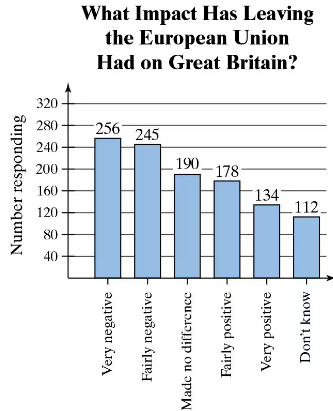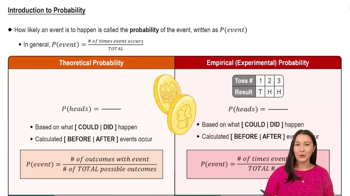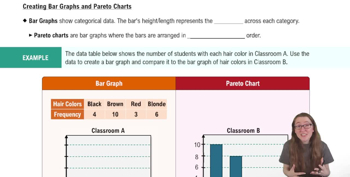39. You are given that P(A) = 0.15 and P(B) = 0.40. Do you have enough information to find P(A or B)? Explain.
Table of contents
- 1. Intro to Stats and Collecting Data1h 14m
- 2. Describing Data with Tables and Graphs1h 55m
- 3. Describing Data Numerically2h 5m
- 4. Probability2h 16m
- 5. Binomial Distribution & Discrete Random Variables3h 6m
- 6. Normal Distribution and Continuous Random Variables2h 11m
- 7. Sampling Distributions & Confidence Intervals: Mean3h 23m
- Sampling Distribution of the Sample Mean and Central Limit Theorem19m
- Distribution of Sample Mean - Excel23m
- Introduction to Confidence Intervals15m
- Confidence Intervals for Population Mean1h 18m
- Determining the Minimum Sample Size Required12m
- Finding Probabilities and T Critical Values - Excel28m
- Confidence Intervals for Population Means - Excel25m
- 8. Sampling Distributions & Confidence Intervals: Proportion1h 12m
- 9. Hypothesis Testing for One Sample3h 29m
- 10. Hypothesis Testing for Two Samples4h 50m
- Two Proportions1h 13m
- Two Proportions Hypothesis Test - Excel28m
- Two Means - Unknown, Unequal Variance1h 3m
- Two Means - Unknown Variances Hypothesis Test - Excel12m
- Two Means - Unknown, Equal Variance15m
- Two Means - Unknown, Equal Variances Hypothesis Test - Excel9m
- Two Means - Known Variance12m
- Two Means - Sigma Known Hypothesis Test - Excel21m
- Two Means - Matched Pairs (Dependent Samples)42m
- Matched Pairs Hypothesis Test - Excel12m
- 11. Correlation1h 6m
- 12. Regression1h 50m
- 13. Chi-Square Tests & Goodness of Fit1h 57m
- 14. ANOVA1h 57m
4. Probability
Addition Rule
Problem 3.3.22b
Textbook Question
22. Brexit A survey asked 1115 British adults how Britain's decision to leave the European Union has impacted the country. The results are shown in the Pareto chart. Find the
probability of each event. (Adapted from Ipsos)
b. Randomly selecting a British adult who feels that the move has had a very negative impact on Great Britain

 Verified step by step guidance
Verified step by step guidance1
Step 1: Identify the total number of respondents in the survey. According to the problem, the total number of British adults surveyed is 1115.
Step 2: Locate the number of respondents who feel that the move has had a 'very negative' impact. From the Pareto chart, this value is 256.
Step 3: Recall the formula for probability: \( P(A) = \frac{\text{Number of favorable outcomes}}{\text{Total number of outcomes}} \). Here, the favorable outcome is the number of respondents who feel the impact is 'very negative', and the total number of outcomes is the total number of respondents.
Step 4: Substitute the values into the formula: \( P(\text{Very Negative}) = \frac{256}{1115} \).
Step 5: Simplify the fraction if necessary to express the probability in its simplest form or as a decimal.
 Verified video answer for a similar problem:
Verified video answer for a similar problem:This video solution was recommended by our tutors as helpful for the problem above
Video duration:
2mPlay a video:
Was this helpful?
Key Concepts
Here are the essential concepts you must grasp in order to answer the question correctly.
Probability
Probability is a measure of the likelihood that a particular event will occur, expressed as a number between 0 and 1. In this context, it refers to the chance of randomly selecting a British adult who perceives the impact of Brexit as 'very negative.' This can be calculated by dividing the number of respondents who selected 'very negative' by the total number of respondents.
Recommended video:

Introduction to Probability
Pareto Chart
A Pareto chart is a type of bar graph that represents the frequency or impact of problems in a descending order. It helps to visualize the most significant factors in a dataset. In this case, the chart displays the responses of British adults regarding the impact of Brexit, allowing for easy identification of the most common perceptions.
Recommended video:

Creating Bar Graphs and Pareto Charts
Survey Sampling
Survey sampling involves selecting a subset of individuals from a larger population to gather insights about that population. In this scenario, 1,115 British adults were surveyed to understand their views on Brexit. The sample size is crucial for ensuring that the results are representative and can be generalized to the broader population.
Recommended video:

Sampling Distribution of Sample Proportion

 5:14m
5:14mWatch next
Master Probability of Mutually Exclusive Events with a bite sized video explanation from Patrick
Start learningRelated Videos
Related Practice
Textbook Question
